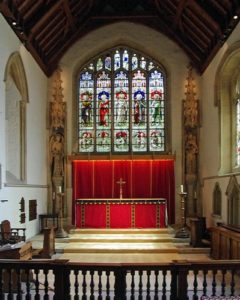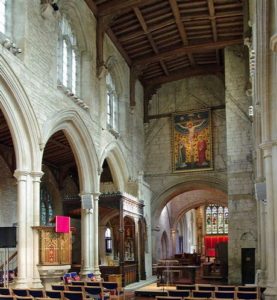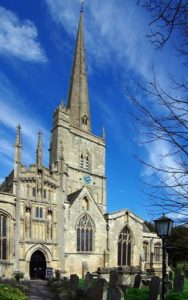This is one of the big Cotswold Wool Churches. It was probably built on the site of a Saxon church. The present church was built in the late 12thC but as the wool trade grew in Burford, so did the church. Extra chantry chapels were added and at its height, Burford had nine separate altars and six incumbent priests. Now it is one of the largest churches in Oxfordshire
The church is at the bottom of the town near the river. The tall slender tower is a local landmark. The church began as a cruciform church with central tower and spire. The Lady Chapel at the south west corner as originally a separate guild chapel but became part of the church during the 15thC.
The splendid 15thC three storey south porch must be one of the largest in the country. It is decorated with blind arches, statues and crocketted pinnacles. Inside there is a lovely fan vaulted roof.
Inside it is a big church, a very big church. Eyes are immediately drawn to the big painting of the crucifixion hanging above the transept crossing. The gold background reflects all the light.
Multiple pillars with pointed arches separate nave and side aisles. Above are plain glass clerestory windows. Other windows are stained glass.
At the back of the church is the huge Lady Chapel with monuments of the Sylvester family, one of the powerful merchant families, on the walls and angels holding shields on the roof corbels. The carved stone reredos has Mary and Jesus in the centre. On the left is St John. On the right is Jesus the Good Shepherd.
At the back of the north aisle is an elaborate carved Norman tub font font with a lid raised by pulleys. An inscription carved on the lead inside the font reads “Anthony Sedley 1649 Prisner” Soon after the end of the Civil War a group of Parliamentarians called the Levellers disagreed with Oliver Cromwell. About 340 were captured near Burford and imprisoned in the church. Three of them were sentenced to death by firing squad while the rest watched from the roof.
On the north wall is Huge Edward Harman memorial. He was barber to Henry VIII and a gentleman of the Privy Chamber. It is a splendid tomb with two panels with praying figures on the base. Above is an inscription with a carving of what is thought to be the earliest example in Europe depicting Amazonian Indians. Harman supposedly had trading interests in Brazil. On the portico is his coat of arms.
On a north arcade pillar is a glorious Baroque altar painted in scarlet and gold. Just beyond is St Peter’s Chapel, set in a carved wooden screen with a glorious painted roof. This was the pew of the Lords of the Manor from 1580-1875. It was rededicated to St Peter in the 1880s when part of a statue of the saint was found by workmen. At the east end is a small altar with an embroidered frontal. The painted reredos has Christ in the centre with the Crowned Virgin on the left and St Dorothy, patron saint of orchards, on the right. Above is St Peter holding the key of Heaven.
On the outside north wall are two of the old bells. The north transept contains the old clock mechanism dating from 1685.
The transept crossing arches are low Norman rounded arches. The crossing has a double Norman arcade round the top. The lower arcade arches are supported on round pillars with carved capitals. Above the arches have no pillars and chevron carvings. Some of the arches have been blocked later to give extra strength as the tower was in danger of collapse.
Beyond the north transept is the north chancel chapel or St Catherine’s Chapel which is separated from the chancel by a carved parclose screen. It contains the magnificent Tanfield tomb, surrounded by metal railings. Sir Lawrence, Chancellor of the Exchequer to James I who died in 1628 and his wife. He was reviled locally for his high-handed interference in local affairs, and had a reputation for greed and corrupt practices in office. For two centuries after his death, Burford residents gleefully burned an effigy of Lord Tanfield each year.
His wife commandeered St Catherine’s Chapel for the memorial, after being refused permission for a tomb in Westminster Abbey. Their painted praying figures lie on a massive black marble base with heads resting on tasselled cushions. Underneath is a skeleton – a reminder of mortality. At their feet is the kneeling figure of their grandson Lucius Cary, resplendent in green and gold armour. He was later killed, fighting for the Royalist cause in the Civil War. Six Corinthian columns support a splendid portico with carved figures above the columns, tall obelisks at the corners and the Tanfield coat of arms.
A squint gives a view of the high altar, which is almost plain in comparison with the rest of the church. It has a bright scarlet frontal and scarlet drapes behind. On either side of the stained glass east window are statues of Gabriel on the left and the Virgin Mary on the right, standing on tall pedestals and set under crocketted pinnacles. An old wooden door lead into the vestry. There are aumbry cupboards on the north wall and piscina and sedilia on the south wall.
The south chancel chapel has a 16thC inscription under the east window from William Tyndales’ translation of the Bible into English. It is part of St Paul’s letter to the Romans. There are copies of Bibles on display.
The south transept contains a huge table tombstone with carved angles round the base holding shields set under ogee arches. It has lost its brass inset. The south window dates from 1907 and is described as the ‘Whall window’ and depicts the revelation of St John.
Up stairs is Thomas a Becket Chapel, which is used for private prayer. This has the remains of wall paintings on the south and east walls. It is difficult to make out any detail, they just look like areas of red paint.
Burford is definitely worth a visit. It is open daily from 9 until 4 or 5pm. There is some parking by the church although we weren’t sure of the status of this. Failing that, there is a large free car park signed off the main street. There are steps into the church with a sign pointing to disabled access round the corner.





